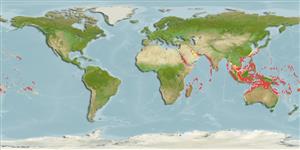Common names from other countries
>
Eupercaria/misc (Various families in series Eupercaria) >
Labridae (Wrasses) > Pseudodacinae
Etymology: Pseudodax: Greek,pseudes = false + Greek, odax, = with the teeth (Ref. 45335).
More on author: Valenciennes.
Environment: milieu / climate zone / depth range / distribution range
Ecología
marino asociado a arrecife; rango de profundidad 3 - 60 m (Ref. 9823), usually 4 - 40 m (Ref. 27115). Tropical; 24°C - 28°C (Ref. 27115); 32°N - 24°S
Indo-Pacific: Red Sea to South Africa (Ref. 35918) and to the Society, Marquesan and Tuamoto islands, north to southern Japan.
Tamaño / Peso / Age
Maturity: Lm ? range ? - ? cm
Max length : 30.0 cm TL macho / no sexado; (Ref. 30573)
Espinas dorsales (total): 11; Radios blandos dorsales (total): 12; Espinas anales 3; Radios blandos anales: 14
Inhabits clear channels and seaward reefs (Ref. 9710). Juveniles are commonly found along drop-offs below 18 m (Ref. 9710). Adults usually found near caves while juveniles frequently live inside them. Adults are solitary and feed on algae and small invertebrates. Juveniles have been observed 'cleaning' other fishes. Because of its dentition, it is regarded as a close relative to the parrotfishes (Scaridae), although it behaves like the species of Anampses.
Life cycle and mating behavior
Madurez | Reproducción | Puesta | Huevos | Fecundidad | Larva
Oviparous, distinct pairing during breeding (Ref. 205).
Westneat, M.W., 2001. Labridae. Wrasses, hogfishes, razorfishes, corises, tuskfishes. p. 3381-3467. In K.E. Carpenter and V. Niem (eds.) FAO species identification guide for fishery purposes. The living marine resources of the Western Central Pacific. Vol. 6. Bony fishes part 4 (Labridae to Latimeriidae), estuarine crocodiles. FAO, Rome. (Ref. 9823)
IUCN Red List Status (Ref. 130435)
CITES (Ref. 128078)
Not Evaluated
Threat to humans
Harmless
Human uses
Pesquerías: escaso valor comercial; Acuario: Comercial
Más información
ReferenciasAcuiculturaPerfil de acuiculturaRazasGenéticaElectrophoresesheritabilidadEnfermedadesProcesamientoMass conversion
ColaboradoresImágenesStamps, Coins Misc.SonidosCiguateraVelocidadTipo de nataciónSuperficie branquialOtolitosCerebrosVisión
Herramientas
Special reports
Download XML
Fuentes de Internet
Estimates based on models
Preferred temperature (Ref.
115969): 25.5 - 29, mean 28 (based on 1384 cells).
Phylogenetic diversity index (Ref.
82804): PD
50 = 1.0000 [Uniqueness, from 0.5 = low to 2.0 = high].
Bayesian length-weight: a=0.01122 (0.00514 - 0.02450), b=3.04 (2.87 - 3.21), in cm Total Length, based on all LWR estimates for this body shape (Ref.
93245).
Nivel trófico (Ref.
69278): 2.8 ±0.26 se; based on food items.
Resiliencia (Ref.
120179): Medio, población duplicada en un tiempo mínimo de 1.4-4.4 años (Preliminary K or Fecundity.).
Fishing Vulnerability (Ref.
59153): Low vulnerability (20 of 100).
